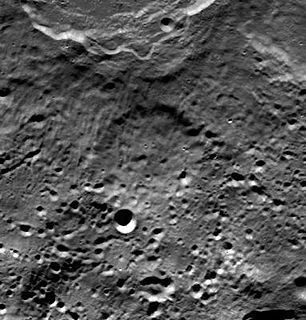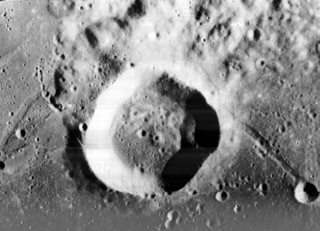
Ammonius is a bowl-shaped lunar impact crater with a slightly raised rim. It is located on the floor of the walled plain Ptolemaeus, about 30 kilometers northeast of the crater midpoint.

Bessarion is a lunar impact crater located near the southwest edge of Mare Imbrium. It is named after Greek scholar Johannes Bessarion. Some distance to the east is the crater T. Mayer. Bessarion is a bowl-shaped crater with a low central rise and a higher albedo than the maria, making it a brighter feature when the sun is overhead.

Bobillier is a tiny, cup-shaped lunar impact crater in the southwest part of Mare Serenitatis. It was named after French geometer Étienne Bobillier in 1976. It lies to the north-northwest of the crater Bessel. To the south and west is a wrinkle ridge designated Dorsum Buckland. Bobillier was previously identified as Bessel E.

Deseilligny is a small lunar impact crater in the southern part of the Mare Serenitatis. It was named after French selenographer Jules Deseilligny. It is located to the east-southeast of the crater Bessel. Deseilligny is a bowl-shaped crater with a low rim. It is otherwise undistinguished.

Finsch is a relatively small lunar impact crater in the mid-part of Mare Serenitatis that has been almost completely covered by the mare, forming a ghost crater in the lava plain. It was named after German zoologist Otto Finsch. It is located to the south-southeast of the crater Sarabhai and northeast of Bessel.

Blagg is a tiny lunar impact crater located on the Sinus Medii. It is a circular crater with no appreciable erosion. To the east-southeast is the irregular crater Rhaeticus, and northeast lies Triesnecker. It is about 33 km to the east of the slightly larger Bruce. It was named after noted English astronomer Mary Adela Blagg. Its diameter is 5.0 km.

Chladni is a small lunar impact crater that lies near the northwest edge of Sinus Medii, in the central part of the Moon. The crater is named for German physicist and musician Ernst Chladni who, in 1794, wrote the first book on meteorites. The rim of the crater is roughly circular, and there is a small central floor at the midpoint of the sloping inner walls. This feature has a higher albedo than the surrounding terrain. It is connected by a low ridge to the rim of the crater Murchison, which lies to the northwest. Due east of Chladni is the larger Triesnecker.

Eudoxus is a prominent lunar impact crater that lies to the east of the northern tip of the Montes Caucasus range. It is named after the Greek astronomer Eudoxus of Cnidus. It is located to the south of the prominent crater Aristoteles in the northern regions of the visible Moon. To the south is the ruined formation of Alexander, and the small crater Lamèch lies to the southwest.

Agatharchides is a lunar impact crater located at the southern edge of Oceanus Procellarum, in the region between the Mare Humorum and Mare Nubium. To the east-southeast is the crater Bullialdus, and to the south-southwest lies Loewy. It is named after the Greek geographer Agatharchides.

Abel is an ancient lunar impact crater that lies near the southeast limb of the Moon's near side. It is located to the south of the crater Barnard, at the northwest edge of the Mare Australe.

Democritus is a lunar impact crater that is located on the northern part of the Moon, just to the north of the Mare Frigoris. Just to the south of Democritus is the lava-flooded crater Gärtner, which forms a bay on the mare. Directly to the north is Arnold, another flooded formation.

Ctesibius is a small lunar impact crater that is located near the equator, on the far side of the Moon. It is named after the ancient Greek-Egyptian inventor Ctesibius. It lies between the larger crater Abul Wáfa to the west and the slightly smaller Heron to the east.

Calippus is a small lunar impact crater that is located on the eastern edge of the rugged Montes Caucasus mountain range in the northern part of the Moon. It was named after Greek astronomer Callippus of Cyzicus. It lies to the southwest of the crater remnant Alexander, to the northwest of the Mare Serenitatis.

Bohr is a lunar impact crater that is located near the western lunar limb, in the area that is affected by librations. It is attached to the southwestern rim of the larger, eroded Vasco da Gama formation, and to the southeast of the crater Einstein. The crater was observed for the first time in 1963 by Arthus and Ewen Whitaker in the book Rectified Lunar Atlas.

Brashear is a lunar impact crater on the far side of the Moon, in the southern hemisphere in the vicinity of the south pole. The crater is named after the American astronomer John A. Brashear. It lies just to the south of the walled plain Antoniadi, within the larger crater's outer rampart of ejecta. To the northeast besides Antoniadi is the crater Numerov, and southeast lies the younger De Forest.

Courtney is a tiny lunar impact crater on the Mare Imbrium, a lunar mare in the northwest quadrant of the Moon. It lies about two crater diameters to the northwest of Euler, in an otherwise isolated stretch of the mare. The dark surface in this region is marked by Euler's ray material. The name is an English male name.

Chappell is a lunar impact crater that is located on the far side of the Moon, in the northern hemisphere just to the north of the crater Debye. This feature is located in a heavily bombarded section of the surface, and much of the outer rim of the crater is overlain by many smaller craters. The northern rim in particular has been almost completely disintegrated, while small craters also overlie the rim to the northwest and southeast. What remains of the rim forms a rounded, somewhat irregular edge to the crater depression.

Chevallier is a lunar impact crater that is located in the northeastern part of the Moon's near side, about a crater diameter east-southeast of the prominent crater Atlas. To the south-southeast of Chevallier is the flooded crater Shuckburgh.
Aepinus is a small lunar impact crater located along the northern lunar limb, close to the north pole of the Moon. To the south east is the prominent crater Hermite.
Bosch is a small lunar impact crater near the North Pole of the Moon. It is located just to the northeast of Rozhdestvenskiy W

























